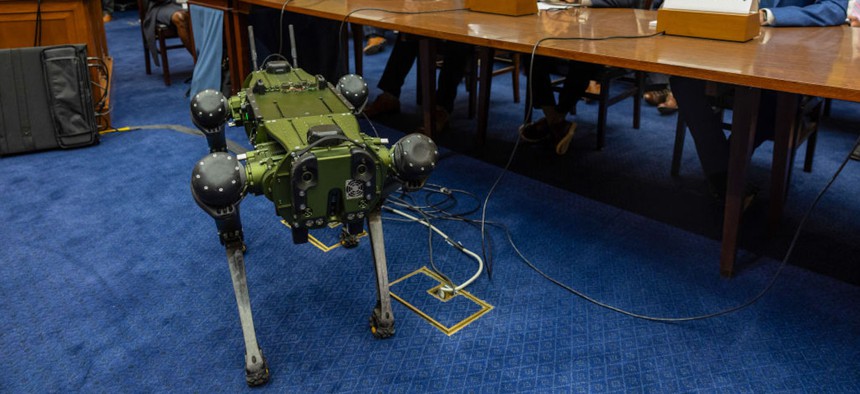
Gavin Kenneally, Chief Executive Officer at Ghost Robotics speaks as Vision 60 UGV walks in during a House hearing at the US Capitol on June 22, 2023 in Washington, DC. The House Committee on Oversight and Accountbility Subcommittee on Cybersecurity, Information Technology, and Government Innovation met to discuss the use of technology at the US Border, airports and military bases Photo by Tasos Katopodis/Getty Images)
Lawmakers want answers from Pentagon on AI developments with Australia, UK
Senators are seeking more information about AI safety within the AUKUS program.
Senior members of the Senate Armed Services Committee want the Pentagon to tell them more about efforts to collaborate with the United Kingdom and Australia to develop next-generation artificial intelligence, according to a letter exclusively obtained by Defense One.
The AUKUS program is a trilateral technology-sharing effort between the three nations; the best-known piece of the agreement is an effort to design and build new nuclear-powered submarines. But the second pillar of the program is arguably more important: a commitment to jointly develop new technologies in undersea warfare, cyber, quantum and particularly artificial intelligence. That includes joint experiments and exercises with new AI-enabled tools.
Lawmakers have been broadly supportive the program, but senators on both sides of the aisle on the Senate Armed Services Committee are concerned that the first pillar, as currently structured, could hurt the U.S. submarine industrial base by forcing the transfer of key technical knowledge on the Virginia-class to Australia and the U.K. in the 2030s—almost a decade before a joint British, Australian, and U.S. submarine can be deployed.
In the letter, the lawmakers ask a number of questions about AI safety, such as::
“Who from DOD is leading the work on AI and autonomy experimentation and exercises in context of AUKUS Pillar 2;”
”If open-source software and systems are being considered for participation, how will safety and security be maintained?;”
“How is the cybersecurity of the capabilities under development being addressed and what is U.S. Cyber Command’s role?;”
And:
“How will the ‘Executive Order on the Safe, Secure, and Trustworthy Development and Use of Artificial Intelligence’ inform DOD’s approach?”
“Mitigating risks to adversarial AI and developing resilient, indigenous AI systems is critical to achieving the objectives of the AUKUS security partnership,” the letter notes.
In theory, answering these questions should be simple. The three militaries have already begun joint work on cyber safeguards for data and autonomy, according to a defense ministers’ statement from December.
“This effort builds on joint work demonstrated in the U.K. in April 2023 and in South Australia in October 2023. The AUKUS nations aim to integrate (Resilient and Autonomous Artificial Intelligence Technologies) into national programs in 2024, to pursue the rapid adoption of these technologies across land and maritime domains,” the statement says.
The three nations have also launched a series of maritime autonomous exercises and experiments. And all three nations have signed on to a key ethics pact on AI, based largely on the Defense Department’s AI principlesl.
The lawmakers’ letter seeks answers by April 12.





